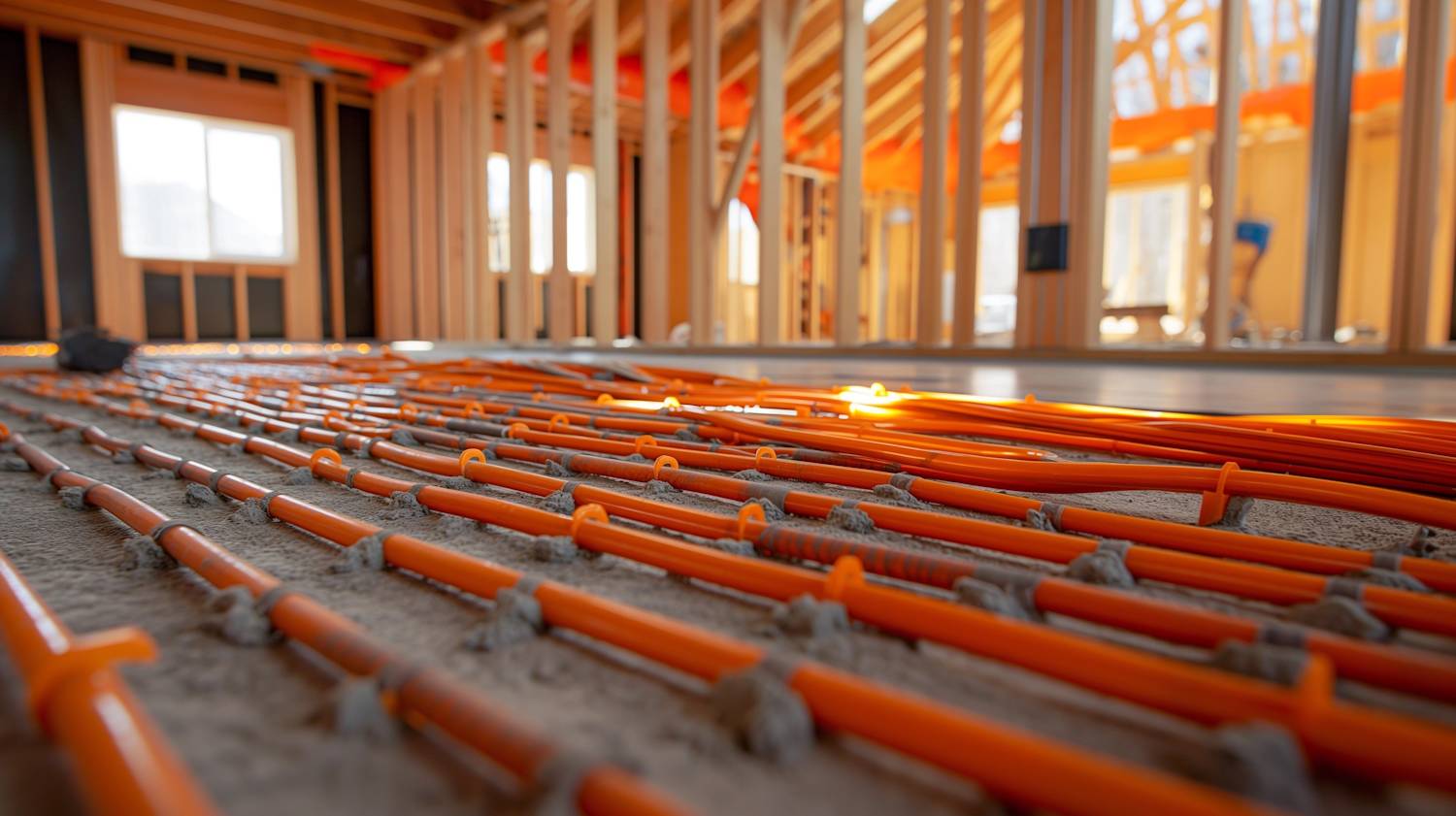Imagine stepping onto a warm surface when it's frigid outside, with every corner of your living space evenly heated. Sound like a luxury? It's not just reserved for high-end residences. This is the beauty of radiant floor heating, a hot trend in modern home construction and remodeling. Let's understand more about it.
What is Radiant Floor Heating?
Radiant floor heating, also known as underfloor heating, provides warmth in a unique way. As opposed to traditional heater units or radiators that only warm the air around them, radiant floor heating heats the entire floor, creating an evenly distributed warmth. It also reduces heat loss, making it more energy-efficient and environmentally friendly.
Different Types of Radiant Floor Heating
There are primarily two types of radiant floor heating systems: electric systems and water-based or hydronic systems.
Electric Radiant Floor Heating
As the name suggests, electric radiant floor heating utilizes electric cables or heating mats embedded under the floor surface. The resistance from these wires generates heat. As electric systems are quite thin, they do not significantly raise the floor height.
Hydronic Radiant Floor Heating
Hydronic floor heating systems utilize water heated by a boiler, pump, or solar energy to heat floors. The heated water passes through a network of pipes laid underneath the flooring to produce warmth. This type of system is more common in new constructions due to its extensive installation process.
The Installation Process of Radiant Floor Heating
While it's true that installing radiant floor heating may be more time-consuming and expensive than traditional heating methods, the long-term benefits are substantial. Let's break down the basic installation process:
-
Subfloor Preparation: The installer removes the existing floor and prepares the surface.
-
Insulation Installation: An insulation layer would be installed to ensure optimal energy efficiency.
-
Heating System Installation: The heating wires or tubes get installed on the insulation. With an electric system, the wires are either directly placed onto the insulation or are part of a preconstructed heating mat.
-
Floor Installation: The new floor is installed over the heating system, regardless of whether it's an electric or a hydronic system.
Where Can Radiant Floor Heating be Used?
Radiant floor heating can be installed in virtually any room. However, for maximal benefit, larger areas and rooms with high heat loss, like bathrooms, basements, or kitchens, are excellent candidates. It can perfectly pair with a wide range of flooring options including tile, stone, hardwood, and laminate.
Is Radiant Floor Heating Energy Efficient?
As per the U.S. Department of Energy, radiant floor heating is indeed more efficient than traditional baseboard heating. As the heat is evenly circulated from the floor, there are minimal losses and maximum heating benefits. It's ideal for home occupants who want to optimize their home heating while minimizing their carbon footprint.
Making the Most Out of Your Radiant Floor Heating
To ensure that you make the most out of your radiant floor heating system, it's important to consider factors such as subfloor type, the type of flooring material, installation process and the room's natural insulation. The collaboration of these factors significantly contributes to the system's performance and your ultimate satisfaction.
Radiant floor heating is a luxurious, energy-efficient, and cost-saving heating option that can be easily adapted to most floor types. It ensures evenly distributed heat, which not only keeps your house warmer but also enchases the comfort and aesthetic appeal of your living space.
Frequently Asked Questions about Radiant Floor Heating
How does radiant floor heating work?
Radiant floor heating operates by directly heating the floor of a house or building. It uses either electric resistance cables or heated water tubes to radiate heat upward and distribute it evenly across the room. This method of heating provides consistent warmth from the floor to the ceiling, ensuring a comfortable environment during the cold months.
What makes radiant floor heating different from other heating systems?
Unlike traditional heating systems that generate heat from a specific source like a radiator or a heating vent, radiant floor heating system distribute heat evenly across the room, providing a uniform level of warmth. As a result, radiant floor heating eliminates cold spots typically experienced with conventional heating methods.
Is radiant floor heating energy efficient?
Yes, radiant floor heating is highly energy efficient. As the heat rises naturally from the floor, less heat is wasted than with traditional heating systems. Also, since it operates at a lower temperature while providing the same level of warmth, it uses less energy overall.
Can radiant floor heating also cool down a house?
No, radiant floor heating systems are specifically designed for heating purposes only. They do not have a cooling mechanism similar to an air conditioning system.
Is radiant floor heating safe?
Yes, radiant floor heating is considered to be very safe. The systems are embedded in the floor, so there are no hot surfaces or materials that could potentially cause burns. Moreover, it does not circulate air, reducing the movement of allergens within the room.
What kind of flooring is best for radiant floor heating?
Typically, materials that conduct heat well and have good thermal mass, like ceramic tile or stone, are preferred choices for radiant floor heating. However, you can use other types of flooring like wood, vinyl, or carpet, but they may not conduct heat as well as tile or stone.
How long does radiant floor heating last?
With proper installation and maintenance, a radiant floor heating system can last for up to 35 to 40 years, making it a highly durable heating solution.
Can radiant floor heating be installed in existing homes?
While easier to install during the construction or renovation process, it’s absolutely possible to retrofit a radiant floor heating system into an existing home. However, keep in mind that this might involve significant modifications to the existing floor structure.
What kind of maintenance does radiant floor heating require?
Maintenance needs for radiant floor heating systems are generally minimal. In case of hydronic (water-based) systems, you'd need to periodically check the boiler and pumps. For electric systems, almost no maintenance is required. However, if something does go wrong, repairs can be intricate as the system is embedded beneath the floor.
Does radiant floor heating increase the value of a home?
Adding radiant floor heating to a home can certainly increase its market value. Many buyers appreciate the efficiency and comfort this system provides, especially in regions with colder climates. It's an investment that could potentially offer good returns when it's time to sell.
Pros of Radiant Floor Heating
Energy Efficiency
The radiant floor heating system showcases superior energy efficiency compared to the conventional forced-air heating system. They reduce the energy consumption by effectively conducting heat throughout the floor, eliminating the need for high levels of energy inflow. This can positively impact your utility bills, saving substantial amounts in the long run.
Even Heating Distribution
Unlike traditional heating methods, radiant heat is more evenly distributed across the room's floor surface. Radiant floor heating works by directly heating the floor that is in direct contact with the heat source, ensuring comprehensive coverage of heat, making the entire space comfortable.
- Eliminates cold spots in the room
- Maximizes and maintains the heat needed for a comfortable room temperature
Quiet Operation
Another notable advantage of radiant floor heating is its silent operation. Unlike forced-air systems that can sometimes be noisy, this heating methodology operates silently and efficiently, contributing to a soothing environment.
Allergy-Friendly
People with allergies can massively benefit from radiant floor heating as it doesn’t disperse allergens or dust particles through vents, which happens frequently in forced-air systems.
Cons of Radiant Floor Heating
Installation Costs
The significant downside of radiant floor heating is the expensive installation costs. These costs are significantly higher than the traditional heating systems and can be a deterrent for budget-conscious homeowners.
- Additional costs include special parts and materials
- Labor costs are pricey due to the complexity of installation
- Installation might take a long time
Installation Limitations
This type of heating system has certain limitations in terms of installation. This method isn’t suitable for all types of flooring. Installing it under hardwood or carpet can sometimes lead to uneven heating or even potential damage to the tiles.
Repair Difficulty
If any issue arises in the radiant floor heating system, repairs may be challenging. Because the system is installed beneath the floor, break down would warrant the excavation of your floor, owning up to more disruptions and expenses.
Increased Floor Height
Lastly, the installation of the radiant floor heating system might cause a slight increase in your floor height. While this might be negligible for some homeowners, it may prove to be an inconvenience for others. It could affect the overall aesthetics and even pose a slight tripping hazard.
Conclusion
Deciding on whether the radiant floor heating system is the best fit for your home requires careful consideration of these pros and cons. While the system offers superior efficiency and comfort, the installation and repair costs can be a deterrent for some. Regardless, understanding these details can help homeowners make an informed decision based on their unique requirements and budgets.
Summary
Radiant floor heating is more than just luxury. This system, while often associated with a higher installation cost, provides an unmatched level of comfort and energy efficiency. By evenly distributing heat from the floor up, it heats your entire environment, rather than just circulating hot air. In the long run, investing in radiant floor heating pays off.
Also, the cleanliness and noise levels associated with radiant floor heating are both major positives. This often unseen system doesn't force dust and allergens around your home like forced-air systems do. Moreover, it operates silently, removing the hum of a running furnace. Overall, radiant floor heating brings a clean and silent upgrade to your indoor atmosphere.
Lastly, radiant floor heating is highly flexible and adaptable. Whether you're building a new home or retrofitting an existing one, there's a radiant floor heating option for you. From electric-based systems perfect for small upgrades, to water-based systems for new constructions. Undoubtedly, radiant floor heating is a versatile solution that enhances both living quality and energy-efficiency.
About KYPD Plumbing
Welcome to KYPD Plumbing, your trusted, local plumbing expert in Nicholasville, KY. With years of experience under our tool belts, we've been proud to offer top-grade emergency repair services, installations and routine maintenance to keep your plumbing system at its best. We are not just a company; we are your neighbors, committed to ensuring your comfort and satisfaction. At KYPD Plumbing, we strive to deliver professional services with a personal touch. Experience the difference of local expertise with a dash of Kentucky charm.
Tags: Radiant Floor Heating, Heating System, Home Improvement,















